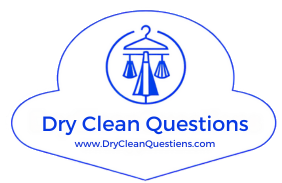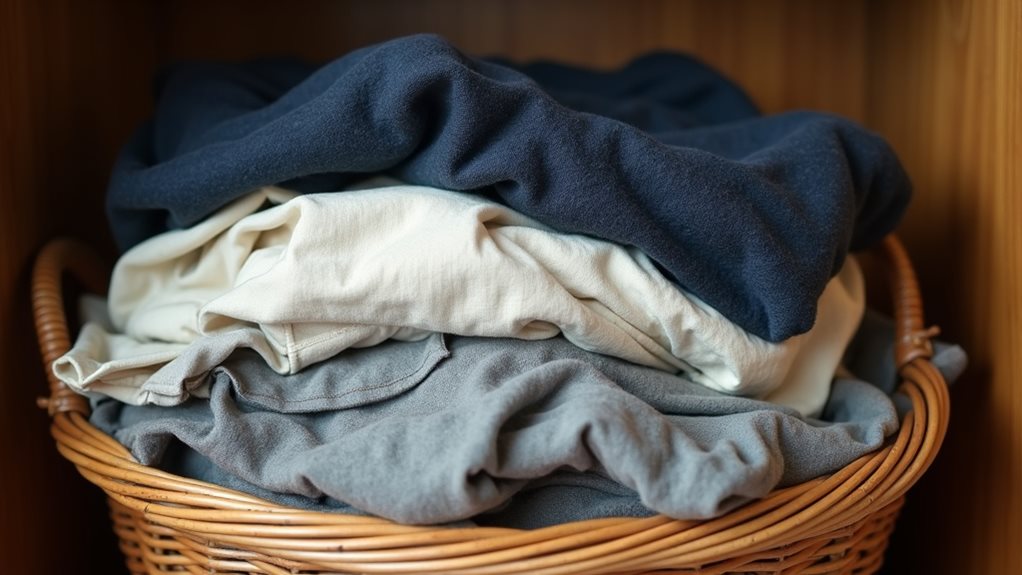You shouldn’t wash clothes before dry cleaning, especially items labeled “dry clean only” like silk blouses, wool suits, or anything with delicate beading—trust me, I’ve learned this lesson the expensive way when my favorite cashmere sweater became doll-sized after one wash cycle. Pre-washing can set stains permanently, cause shrinkage, and create chemical reactions with dry cleaning solvents that’ll damage your garments beyond repair, though understanding the nuances of fabric care will transform how you approach your wardrobe maintenance.
When Pre-Washing Makes Sense Before Dry Cleaning
While most of us have been conditioned to think dry cleaning and regular washing are mutually exclusive, there’s actually a smart middle ground that can save you money and keep your clothes looking fresher longer.
Pre-washing your everyday cotton shirts or polyester blends before sending them to the cleaners isn’t crazy—it’s strategic. When you’ve got visible stains from last night’s pasta dinner (been there!), treating them beforehand prevents them from becoming permanent during the dry cleaning process.
However, resist the urge to toss everything labeled “dry clean only” into your washing machine, as delicate silks and structured blazers need professional care from the start.
Professional dry cleaners use specialized solvents like perchloroethylene that are specifically designed to clean garments without water, making pre-washing unnecessary for most items.
Smart pre-washing means fewer cleaning cycles and longer-lasting garments.
Fabric Types That Should Never Touch Water
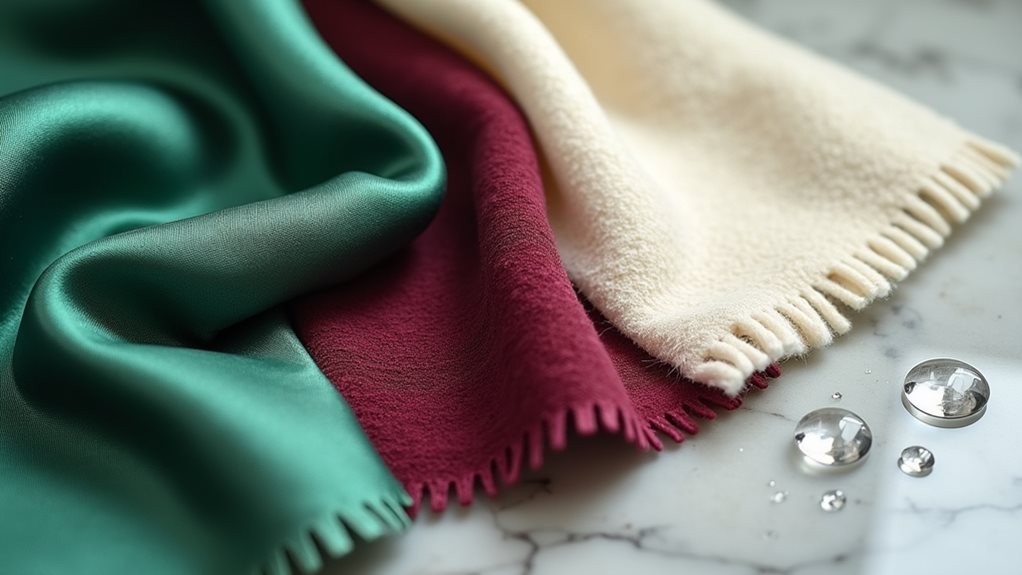
You’ll want to steer clear of water completely when dealing with certain fabrics, because some materials react to moisture like vampires to sunlight – dramatically and with permanent consequences.
Leather and suede top this “never-wet” list, since water transforms these beautiful textures into stiff, discolored disasters that’ll make you question every life choice that led to that laundry moment.
Structured garments with special pleating, interfacing, or architectural details also belong in the hands-off category, as water can turn your crisp blazer into something resembling a deflated balloon animal.
Items with plastic components, sequins, or delicate beading should also avoid water exposure, as moisture can cause adhesives to fail and decorative elements to separate from the fabric permanently.
Leather and Suede
When I first started learning about fabric care, I made the devastating mistake of thinking my expensive leather jacket could handle a gentle hand wash after a coffee spill – and let me tell you, watching $300 worth of buttery-soft leather transform into something resembling cardboard was a lesson I’ll never forget.
Water strips away the natural oils and finishes that keep leather supple, while suede loses its signature texture and becomes stiff beyond repair. You can’t undo this damage, which is why these materials require specialized cleaning products designed specifically for their unique properties.
Professional dry cleaning uses chemical solvents instead of water to safely clean these delicate materials without causing the structural damage that water-based cleaning would inflict.
Instead of risking DIY disasters, consult professional cleaners who understand leather and suede’s delicate nature, and maintain them regularly with proper brushes and conditioners.
Structured Garment Components
The intricate architecture of a well-tailored blazer relies on a hidden network of interfacing, shoulder pads, and canvas layers that work together like the foundation of a house – and just like you wouldn’t flood your basement and expect the structure to remain intact, these garments can’t survive a water-based washing without losing everything that makes them special.
I learned this lesson the hard way when I tossed my favorite wool blazer into the washer, ignoring those special instructions on the care label 😅. The result? A sad, shapeless mess that looked like it belonged in a discount bin.
Structured garments need professional dry cleaning to preserve their architectural integrity, because some things are worth protecting properly. Items with special finishes, embellishments, or intricate details also require this level of professional care to maintain their original appearance and quality.
How to Handle Visible Stains and Odors
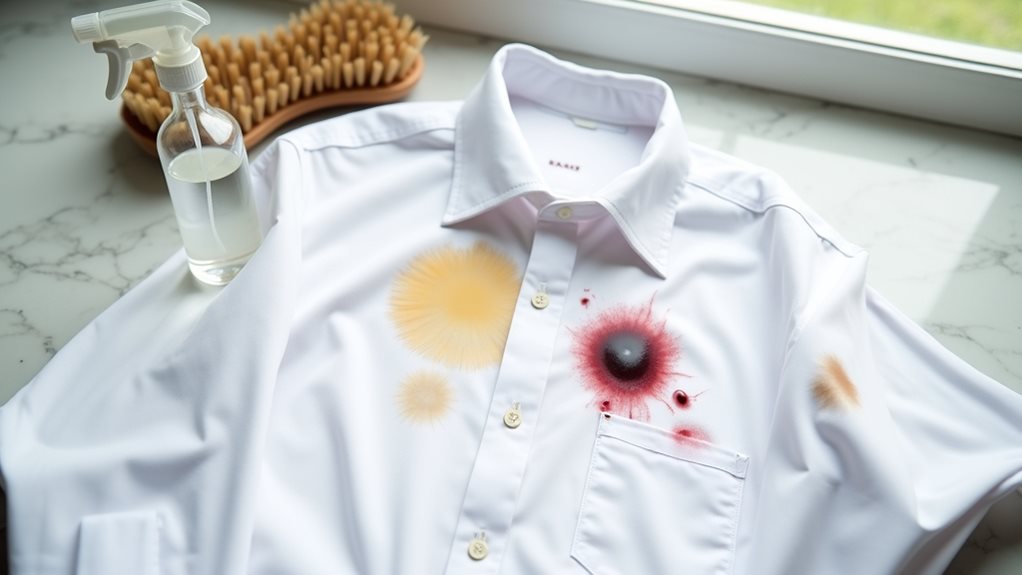
Often, I’ll discover a mysterious stain on my favorite blazer just minutes before I need to head out the door, and while my first instinct used to be panic-rushing to the dry cleaner, I’ve learned that taking a few thoughtful steps at home can make all the difference in whether that stain becomes a permanent reminder of my clumsiness or disappears completely.
When you treat stains proactively, you’re giving your dry cleaner the best chance for success. Mix equal parts white vinegar and water, then gently blot from outside toward center—this prevents spreading the mess further.
Taking action before you reach the dry cleaner dramatically improves your chances of complete stain removal and fabric preservation.
Mark visible stains with masking tape so they get special attention, and always describe what caused them (coffee, ink, mystery sauce from lunch 😅). For odors, air out garments first or use fabric spray before dry cleaning.
These simple steps help clean your clothes more effectively while reducing harsh chemical treatments. However, avoid washing the garment beforehand, as this could set stains permanently and interfere with the dry cleaning solvents’ effectiveness.
The Risk of Damaging Delicate Materials
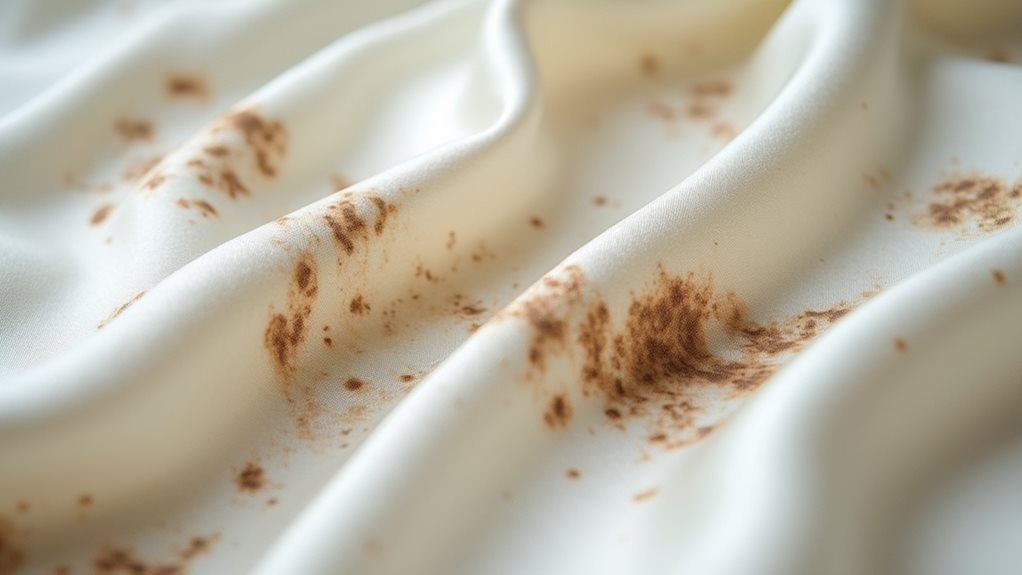
When you’re tempted to pre-wash that gorgeous silk blouse or cashmere sweater before taking it to the dry cleaner, you’re fundamentally playing fabric roulette with some seriously vulnerable materials that can shrink, warp, or bleed their colors faster than you can say “oops.” 😬
Water becomes the enemy for these delicate darlings, since different fabric types react unpredictably to moisture, heat, and agitation, turning your favorite pieces into expensive cleaning rags.
The real kicker is that even gentle detergents can trigger chemical reactions with certain dyes and fibers, creating permanent damage that no amount of professional intervention can reverse.
While traditional dry cleaning chemicals like perchloroethylene can pose health concerns, many facilities are now adopting safer alternatives such as wet cleaning and liquid CO2 that are gentler on both fabrics and human health.
Fabric Type Vulnerabilities
Although I’ve learned this lesson the hard way through countless wardrobe mishaps, I can’t stress enough how certain fabrics will absolutely revolt against traditional washing methods, leaving you with expensive regrets hanging in your closet.
Silk blouses turn into doll clothes, wool sweaters become felted disasters, and don’t even get me started on what happens to cashmere when it meets hot water 😩.
The chemicals used in regular detergents attack these delicate fabrics like they’re public enemy number one, breaking down fibers and destroying that luxurious texture you paid good money for.
While dry cleaning at home kits exist, they’re honestly no match for professional solvents that treat your precious garments with the respect they deserve.
Professional dry cleaners use specialized solvents and techniques that simply cannot be replicated in your home washing machine, making them essential for preserving the quality and extending the life of your most treasured garments.
Water Damage Risks
Water becomes your garment’s worst enemy the moment it saturates those delicate materials, transforming your favorite pieces into tragic shadows of their former selves through a process that’s both swift and merciless.
I learned this lesson the hard way when I tossed my cashmere sweater into the washing machine, watching it emerge as a toddler-sized disaster 😅. Those “dry clean only” labels aren’t suggestions—they’re desperate pleas from manufacturers who understand water damage better than we do.
Silk loses its lustrous sheen, wool shrinks beyond recognition, and intricate beadwork falls apart like autumn leaves. The agitation weakens fibers, creating microscopic tears that spread with each wear, while colors bleed and fade into muddy disappointment.
Fortunately, safer alternatives like wet cleaning and liquid CO2 methods have emerged as eco-friendly options that can protect delicate fabrics without the harsh chemicals traditionally used in dry cleaning.
Chemical Reaction Concerns
Beyond the immediate devastation that water wreaks on delicate fabrics, there’s an equally sinister threat lurking in your laundry room that most people never consider—the unpredictable chemical warfare that erupts when household detergents meet specialized fabric treatments.
Those “dry clean only” labels aren’t just suggestions; they’re warnings about potential chemical reactions that could permanently destroy your favorite pieces.
I learned this the hard way when I tried to remove stains from a silk blouse using regular detergent, only to watch the dyes bleed into psychedelic swirls 😅.
The harsh alkalines in household cleaners clash violently with delicate fabric finishes, weakening fibers and causing discoloration that even professional dry cleaners can’t reverse—making your well-intentioned pre-wash attempt a costly mistake.
Additionally, residual chemicals from dry cleaning solvents that weren’t properly removed can react unpredictably with home detergents, potentially creating new compounds that could damage both your clothing and irritate your skin.
What Professional Dry Cleaners Recommend
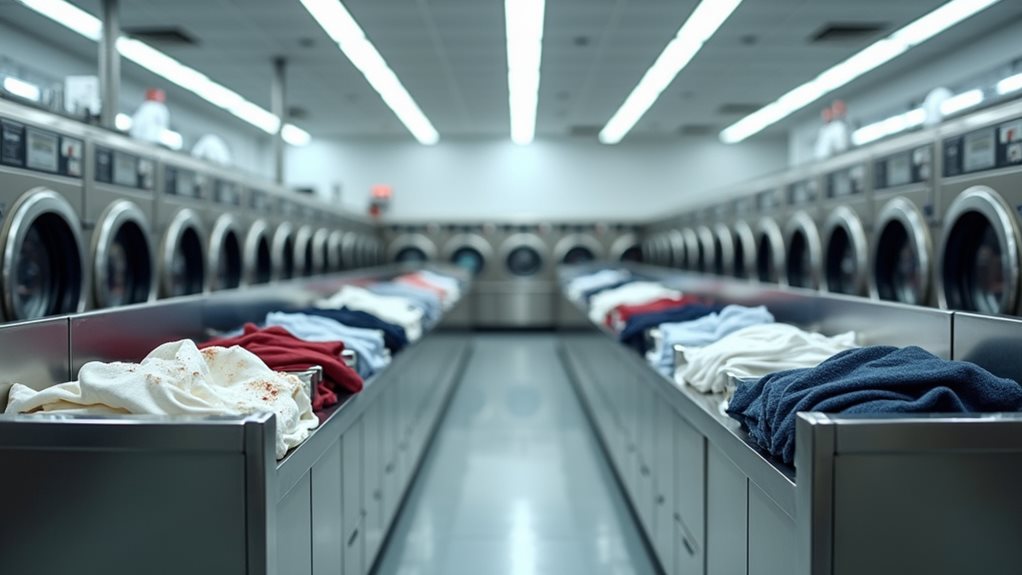
When I first started taking my clothes to professional dry cleaners, I made the rookie mistake of washing everything at home first, thinking I was being helpful by giving them a “head start” on the cleaning process.
Don’t pre-wash clothes before taking them to dry cleaners—you’re not being helpful, you’re actually making their job harder.
Boy, was I wrong! 😅 Professional dry cleaners actually prefer receiving unwashed garments because their specialized solvents and techniques are designed to clean fabrics without water’s potential damage.
They’ve told me repeatedly that pre-washing can shrink delicate items, set certain stains permanently, or alter fabric texture in ways that complicate their work.
Instead, they appreciate when you point out specific stains and explain what caused them, allowing their expertise to determine the best treatment approach.
The dry cleaning process uses chemical solvents like perchloroethylene instead of water, which is particularly effective for delicate fabrics like silk and wool that could be damaged by traditional washing methods.
Trust their process—it’s what you’re paying for.
Cost Considerations of Double Processing

Speaking of trusting the professionals, let me share how I learned about the financial side of this equation the hard way—by literally paying twice for the same results! 💸
Double processing your garments, which happens when you wash items at home before taking them to the dry cleaner, doesn’t just waste your time and effort; it also hits your wallet harder than you’d expect.
Most dry cleaners charge per item regardless of whether you’ve pre-washed it, so you’re fundamentally paying for unnecessary cleaning cycles.
The cost considerations become even more painful when fabrics get damaged during your home washing attempt, requiring expensive repairs or complete replacement after you dry clean them anyway.
Alternative Methods to Freshen Garments at Home
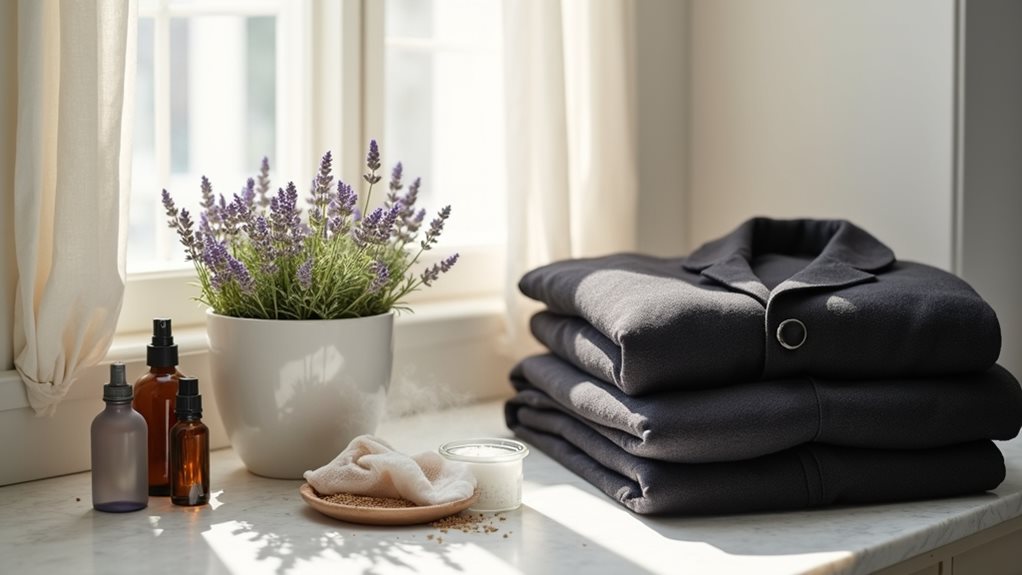
Why does it feel like we’re always stuck between a rock and a hard place when our favorite blazer smells like last night’s dinner but the care label screams “Dry Clean Only”? 🤔
I’ve discovered that you don’t actually need to choose between expensive professional cleaning and risky home washing, because there’s a whole toolkit of gentle methods that can refresh your garments right in your own closet.
Steam cleaning works wonders for releasing wrinkles while eliminating odors, and I love using a clean white sock on my steamer for extra gentle care.
Pro tip: Steam your delicate garments through a clean white sock for the gentlest possible fabric care at home.
Spot cleaning with equal parts white vinegar and water tackles localized stains beautifully, while airing clothes outside in fresh air naturally refreshes fabrics.
Even fabric sprays can revitalize your garments without damage.
